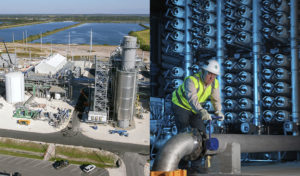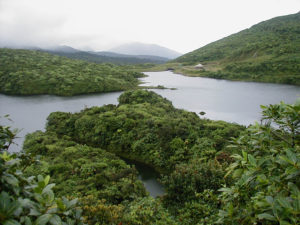Managing Water
Water plays a critical role in generating electricity at our hydro and thermal power plants. Whether we are drawing water to turn hydro turbines, or to create steam or cooling water in our thermal plants, we take care not to impact plants or animals in the area.
Our companies discharge water in compliance with current environmental regulations and operating permits and make every effort to avoid unplanned discharges. No water bodies were significantly affected by discharges from Emera’s facilities in 2016.
Managing water use in Florida

Polk Power Station initially used groundwater drawn from wells to supply process and cooling water for the plant. Now, through Tampa Electric’s Reclaimed Water Project, the team collects reclaimed water from the city of Lakeland, treats it and uses it as cooling water. A future phase will include water from other neighboring communities. The award-winning project is a partnership between Tampa Electric, the city of Mulberry, Polk County and Southwest Florida Water Management District. Our largest electric utility, Tampa Electric had 252,152,673 litres of water discharged in 2016.
Big Bend and Bayside generation stations circulate large amounts of saltwater from Tampa Bay for cooling water. The water is returned to the bay from the plants by a process known as “once-through cooling.” This return also serves as the intake for the Tampa Bay Seawater Desalination plant, which provides up to 25 million gallons per day of drinking water to the region. The reverse osmosis facility benefits from using seawater that has already passed through the intake system at Big Bend. Reusing water from Big Bend eliminates the need for a second intake and reduces the salinity of water discharged into Tampa Bay.
Big Bend and Bayside also reuse rainwater and process water through diversion and collection systems. The drainage system at Big Bend diverts reuse water to the station’s lined industrial wastewater ponds. And, to offset potable water use, Big Bend receives about 2.5 million gallons per day of treated wastewater effluent from Hillsborough County.
Sustaining Hydroelectric Generation

Hydroelectric facilities have been part of the backbone of electricity generation in Nova Scotia since the early 20th century, and continue to play a critical role in achieving renewable energy targets. Nova Scotia Power operates 32 hydroelectric generating stations in 16 river systems across the province. We operate our hydroelectric systems to create a sustainable balance between public and team member safety, protection of the environment, generation of renewable electricity, and recreational uses of the watercourse. All the systems are run-of-river, following the natural seasonal flow of the rivers.
Nova Scotia Power has made a considerable investment in its hydroelectric generation systems to ensure dam safety requirements are met, to improve fish passage and to redevelop generation infrastructure. We manage our hydroelectric dams in accordance with the Canadian Dam Association safety guidelines. We perform dam safety reviews on a seven-year cycle, including flood studies, comprehensive hydrological reviews and climate assessments. This information is used to determine the capital investment required to upgrade the hydroelectric infrastructure. In 2016, the budget for hydroelectric infrastructure renewal was almost $8 million, with another $225 million planned over the next five years.
Similarly, Dominica Electricity Services has the capacity to generate about one-third of its electricity using hydroelectricity, drawing from three run-of-the-river hydro plants on the Roseau River. The steep terrain in Dominica means the hydro system can be powered by smaller river diversions, without the need for larger dams, which ultimately leads to a smaller environmental impact. In 2016, our team in Dominica completed significant restoration work to hydro systems, required after Tropical Storm Erika caused widespread damage the previous year. As a result of the team’s investment and hard work, hydroelectric generation was restored to full capacity in 2016.
